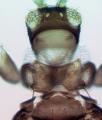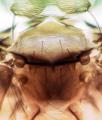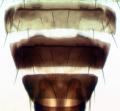Neohydatothrips samayunkur
Recognition data
Distinguishing features
Both sexes fully winged. Body bicolored, mainly dark brown with abdominal segments III–VI yellowish with brown antecostal ridge; pronotum yellow at anterior margin, also all tarsi, base and apex of tibiae, and base antennal segments II–V; fore wings pale with two transverse dark areas, small dark area at base. Antennae 8-segmented, III–IV with short forked sensorium. Head with three pairs of ocellar setae, pair III on anterior margins of triangle; postocular region short. Pronotum anterior half with transversely elongate reticles, "blotch" darker with closely spaced striae; posteroangular setae 65 microns. Metanotal striations transverse at anterior, closely longitudinal medially. Fore wing with first vein setal row complete Abdominal tergites II–V median setae often with distance between their bases scarcely twice diameter of setal pore; VII–VIII with posteromarginal comb of microtrichia complete. Sternites with many microtrichia medially as well as laterally.
Related and similar species
This introduced, strikingly bicolored pest of Marigold plants is similar to N. burungae and N. variabilis in having microtrichia across the median area of the abdominal sternites. It difers from variabilis in having brown markings on the hind tibiae, and in tergites IX–X being as dark brown as VII–VIII. Unfortunately, samayunkur was misidentified by Mound & Marullo (1996) as a species known only from Mexico, Neohydatothrips pseudoannulipes Johansen, this error being recognized subsequently by Nakahara (1999). The genus Neohydatothrips is found in many parts of the world and almost 100 species are included. Identification keys are available to 13 species recorded from Central America (Mound & Marullo, 1996), and Stannard (1968) treats 11 species from Illinois, but many of the 35 species described from the USA north of Mexico (Nakahara, 1988) remain poorly defined.
Taxonomic data
Current valid name
Neohydatothrips samayunkur (Kudo)
Original name and synonyms
- Hydatothrips (Neohydatothrips) samayunkur Kudo, 1996: 169
- Neohydatothrips pseudoannulipes - misidentification, Mound & Marullo, 1996; NOT Johansen, 1983
Family placement
Thripidae, Sericothripinae
Common names
Marigold thrips
Biological data
Life history
Breeding in flowers and on leaves.
Host plants
Tagetes spp. (Asteraceae)
Tospoviruses vectored
None
Crop damage
Severe leaf deformation on cultivated Tagetes erecta (African marigolds).
Distribution data
Area of origin
Not clear, possibly Mexico.
Distribution
USA (Florida, California, Hawaii), Mexico, El Salvador, Costa Rica, Japan, Australia, Sri Lanka, Kenya.








